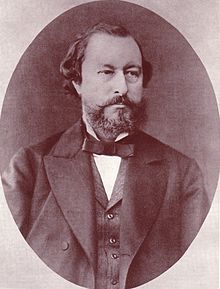Edward Alfred Cowper
Edward Alfred Cowper (born December 10, 1819 in London , † May 9, 1893 in Rastricke, Pine Grove, Weybridge , Surrey ) was a British engineer and inventor .
Life
Edward Alfred Cowper, the son of Edward Shickle Cowper and Ann Applegath, began an apprenticeship at the age of 14 in John Braithwaite's London machine factory and spent a total of seven years there. He then moved to " Fox, Henderson & Co. " in Birmingham . After working on the designs for the buildings for the 1851 World Exhibition in London , he settled there as a freelance, consulting engineer. During this time he designed, among other things, the roof structure of the Birmingham New Street train station with a span of 70 meters, which was sensational at the time.
In 1841 he invented the detonator , a means to be able to warn trains of dangers in an emergency in railway operations . The invention was used all over the world and some railways still have the obligation that every train has to carry blasting capsules. A new casting process for rail chairs followed during his time at "Fox, Henderson & Co.". In 1868, Cowper developed a bicycle with tangential spokes (Patent No. 3886 of December 21, 1858) and rubber tires. A compound machine and an electric telegraph are also among the multitude of his developments.
Edward Alfred Cowper is one of the founding members of the Institution of Mechanical Engineers , of which he was elected President in 1880/81. He was also a board member of the Institution of Civil Engineers and a founding member of the Iron and Steel Institute .
In 1893 Cowper died of pneumonia at his home in Pine Grove, Weybridge, Surrey. He left behind his wife Juliana and a son.
Outstanding performance
One of Cowper's greatest achievements is the new development, named after him, of the blast furnace heater , which replaced the "Wasseralfinger heater" from Faber du Faur that had been used until then .
The seven-part patent was applied for on May 19, 1857 under the name “Invention of Improvements in Furnaces for Heating Air and Other Elastic Fluids” and was granted on August 7 of the same year. The parts under patent protection included the regenerator itself, which was housed in an airtight, fire-proof lined sheet metal housing and through which flow channels for blast furnace gas and cold air ran; the use of two alternately operated generators, which guaranteed an uninterrupted supply of the blast furnace with a hot blast under constant pressure; one or more lockable hearths that are essential for alternating operations; as well as the heating of the regenerator with furnace gas , but also other flammable furnace gases.
To this day, “Cowper wind heaters” are used in the metallurgical industry to generate hot air for all types of melting furnaces.
literature
- H. Dickmann: A Hundred Years of Cowper Wind Heating (1857–1957) . Ed .: Brohltal AG for stone and clay industry. No. 1042 . Burgbrohl, District Koblenz 1958.
Individual evidence
- ^ Lionel Thomas Caswell Rolt : Red for Danger . Edition: London 1978, p. 34.
- ↑ The Development Of The Suspension Wheel ( Memento of the original from September 23, 2015 in the Internet Archive ) Info: The archive link was inserted automatically and has not yet been checked. Please check the original and archive link according to the instructions and then remove this notice. (English, PDF 2.5 MB)
Web links
- The Best of British Engineering 1750-1960 - Edward Alfred Cowper in Grace's Guide of British Engineering
| personal data | |
|---|---|
| SURNAME | Cowper, Edward Alfred |
| BRIEF DESCRIPTION | British engineer |
| DATE OF BIRTH | December 10, 1819 |
| PLACE OF BIRTH | London |
| DATE OF DEATH | May 9, 1893 |
| Place of death | Rastricke, Pine Grove, Weybridge , Surrey |
